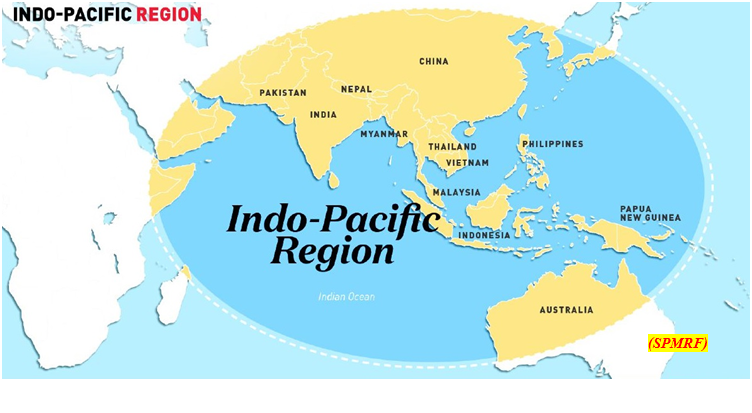Connecting Indias East with the Indo-Pacific (GS Paper 2, International Relation)

Context:
- Since 2018, India’s ‘Look East’ and ‘Act East’ policies have moved into the phase of Indo-Pacific policy and strategy.
- The more important issues still are the need to ensure adequate security, speed up economic development, and connect better with the rest of India and select South Asian and Southeast Asian nations.
- Hence, an effective way to work for a ‘free, open, inclusive, peaceful and prosperous’ Indo-Pacific is to see how these five characteristics may be made more applicable to India’s North eastern region.
Local needs and priorities of Northeast:
- The Northeast which comprises seven ‘sisters’ or States and one ‘brother’, Sikkim, has been witnessing transformation as it heads towards better security conditions and development.
- Recent participation in policy conversations in Imphal, the capital of Manipur, one of the four States bordering Myanmar (Arunachal Pradesh, Nagaland and Mizoram are the others) helped in clarifying local needs and priorities.
- Separately, wide-ranging interactions with the intelligentsia and artists in Kolkata shed light on how this major metropolis views the Indo-Pacific from the lens of culture.
- A key takeaway is that by absorbing and factoring in the perspectives of stakeholders at the ground level, the Indo-Pacific policy can deliver better results.
Insecurities of India’s Northeast:
- Both Indo-Pacific conclaves were hosted by the Asian Confluence, a think tank leading in the study of India’s Northeast. The first was in partnership with the Ministry of External Affairs and Manipur University, and the second had the United States Consulate General in Kolkata as the partner.
- The view from Manipur was that security conditions have improved significantly. However, the core issues behind the insurgency have remained unresolved. The way forward was to address them substantially and accelerate the pace of development.
- A notable contrast in security assessments of the authorities and others came to the fore. The official perspective was that the pernicious phenomena of smuggling, drug trafficking, transnational border crime, insurgent activity, and the influx of refugees (from Myanmar) represented serious non-traditional threats. China was viewed as a ‘constant player’ behind these nefarious activities. This has necessitated vigilance and strict action by the Assam Rifles and other security agencies.
- Others representing local communities, however, expressed concern over the insensitive handling of those engaged in lawful exchanges with the neighbouring countries. A balanced view indicates that considerable scope exists for more effective and people-sensitive border management in the future.
Development as priority:
- The Northeast is on the right path to concentrate on economic development. More is awaited through improvement in roads linking northeastern towns and job creation for thousands of graduates produced by local universities.
- Manipur needs to be promoted as the hub of medical tourism for other Indian States and neighbours such as Myanmar.
- The State’s research and development facilities to leverage the region’s biodiversity should be expanded. Accelerated development requires increased investment by Indian corporates and foreign investors as well as better management.
Cultural dimensions & Indo-Pacific:
- At Kolkata, intellectuals and performers in the cultural domain from India, the U.S., Japan, Thailand, Sri Lanka, and Bangladesh reflected on the Indo-Pacific construct’s cultural dimensions.
- An ambitious endeavour by 75 artists from nine countries highlighted the region’s ‘unity in diversity’ through music, dance, drama, and cuisine.
- Clearly, expanding the reach of cultural diplomacy and people-to-people cooperation through greater educational exchanges, tourism, and trade is desirable.
- The shared culture, history and mutual social threads that tie the region with India also an important component towards fostering regional cooperation.
Conclusion:
- Diplomats from the region agree on the importance of expanded people-related cooperation which would lead to wider acceptance of the Indo-Pacific and consolidation of the Quad. Two common threads have emerged from recent exchanges:
- The growing significance of the Bay of Bengal region permeates the thinking of scholars. The concept of the Indo-Pacific seems distant, but the moment it is perceived as the outer circle of the Bay of Bengal and its littorals, it comes closer to home. Therefore, member-states need to invest more in the Bay of Bengal Initiative for Multi-Sectoral Technical and Economic Cooperation (BIMSTEC) to enhance its effectiveness.
- In implementing India’s Indo-Pacific strategy, voices from Northeast and eastern India must be heard. Thus, beyond ‘Look East’ and ‘Act East’ lies ‘Think and Relate East’, especially India.


